Oxygen
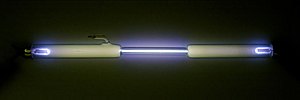 Oxygen-filled discharge tube glowing purple. | |||||||||||||||||||||||||||||||
| Oxygen | |||||||||||||||||||||||||||||||
|---|---|---|---|---|---|---|---|---|---|---|---|---|---|---|---|---|---|---|---|---|---|---|---|---|---|---|---|---|---|---|---|
| Allotropes | O2, O3 (ozone) and more (see Allotropes of oxygen) | ||||||||||||||||||||||||||||||
| Appearance | Gas: colorless Liquid and solid: light sky-blue | ||||||||||||||||||||||||||||||
| Standard atomic weight Ar°(O) | |||||||||||||||||||||||||||||||
ppm | |||||||||||||||||||||||||||||||
| Oxygen in the periodic table | |||||||||||||||||||||||||||||||
| |||||||||||||||||||||||||||||||
kJ/mol | |||||||||||||||||||||||||||||||
| Heat of vaporization | (O2) 6.82 kJ/mol | ||||||||||||||||||||||||||||||
| Molar heat capacity | (O2) 29.378 J/(mol·K) | ||||||||||||||||||||||||||||||
Vapor pressure
| |||||||||||||||||||||||||||||||
| Atomic properties | |||||||||||||||||||||||||||||||
Discovery | Michael Sendivogius Carl Wilhelm Scheele (1604, 1771) | ||||||||||||||||||||||||||||||
| Named by | Antoine Lavoisier (1777) | ||||||||||||||||||||||||||||||
| Isotopes of oxygen | |||||||||||||||||||||||||||||||
| |||||||||||||||||||||||||||||||
Oxygen is a
All
Many major classes of
Oxygen was isolated by Michael Sendivogius before 1604, but it is commonly believed that the element was discovered independently by Carl Wilhelm Scheele, in Uppsala, in 1773 or earlier, and Joseph Priestley in Wiltshire, in 1774. Priority is often given for Priestley because his work was published first. Priestley, however, called oxygen "dephlogisticated air", and did not recognize it as a chemical element. The name oxygen was coined in 1777 by Antoine Lavoisier, who first recognized oxygen as a chemical element and correctly characterized the role it plays in combustion.
Common uses of oxygen include production of
.History of study
Early experiments
One of the first known experiments on the relationship between combustion and air was conducted by the 2nd century BCE Greek writer on mechanics, Philo of Byzantium. In his work Pneumatica, Philo observed that inverting a vessel over a burning candle and surrounding the vessel's neck with water resulted in some water rising into the neck.[7] Philo incorrectly surmised that parts of the air in the vessel were converted into the classical element fire and thus were able to escape through pores in the glass. Many centuries later Leonardo da Vinci built on Philo's work by observing that a portion of air is consumed during combustion and respiration.[8]
In the late 17th century, Robert Boyle proved that air is necessary for combustion. English chemist John Mayow (1641–1679) refined this work by showing that fire requires only a part of air that he called spiritus nitroaereus.[9] In one experiment, he found that placing either a mouse or a lit candle in a closed container over water caused the water to rise and replace one-fourteenth of the air's volume before extinguishing the subjects.[10] From this, he surmised that nitroaereus is consumed in both respiration and combustion.
Mayow observed that antimony increased in weight when heated, and inferred that the nitroaereus must have combined with it.[9] He also thought that the lungs separate nitroaereus from air and pass it into the blood and that animal heat and muscle movement result from the reaction of nitroaereus with certain substances in the body.[9] Accounts of these and other experiments and ideas were published in 1668 in his work Tractatus duo in the tract "De respiratione".[10]
Phlogiston theory
Robert Hooke, Ole Borch, Mikhail Lomonosov, and Pierre Bayen all produced oxygen in experiments in the 17th and the 18th century but none of them recognized it as a chemical element.[11] This may have been in part due to the prevalence of the philosophy of combustion and corrosion called the phlogiston theory, which was then the favored explanation of those processes.[12]
Established in 1667 by the German alchemist
Highly combustible materials that leave little residue, such as wood or coal, were thought to be made mostly of phlogiston; non-combustible substances that corrode, such as iron, contained very little. Air did not play a role in phlogiston theory, nor were any initial quantitative experiments conducted to test the idea; instead, it was based on observations of what happens when something burns, that most common objects appear to become lighter and seem to lose something in the process.[8]
Discovery
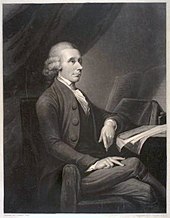
Polish
It is also commonly claimed that oxygen was first discovered by Swedish pharmacist
In the meantime, on August 1, 1774, an experiment conducted by the British clergyman Joseph Priestley focused sunlight on mercuric oxide contained in a glass tube, which liberated a gas he named "dephlogisticated air".[17] He noted that candles burned brighter in the gas and that a mouse was more active and lived longer while breathing it. After breathing the gas himself, Priestley wrote: "The feeling of it to my lungs was not sensibly different from that of common air, but I fancied that my breast felt peculiarly light and easy for some time afterwards."[11] Priestley published his findings in 1775 in a paper titled "An Account of Further Discoveries in Air", which was included in the second volume of his book titled Experiments and Observations on Different Kinds of Air.[8][19] Because he published his findings first, Priestley is usually given priority in the discovery.
The French chemist Antoine Laurent Lavoisier later claimed to have discovered the new substance independently. Priestley visited Lavoisier in October 1774 and told him about his experiment and how he liberated the new gas. Scheele had also dispatched a letter to Lavoisier on September 30, 1774, which described his discovery of the previously unknown substance, but Lavoisier never acknowledged receiving it. (A copy of the letter was found in Scheele's belongings after his death.)[18]
Lavoisier's contribution

Lavoisier conducted the first adequate quantitative experiments on
In one experiment, Lavoisier observed that there was no overall increase in weight when tin and air were heated in a closed container.[17] He noted that air rushed in when he opened the container, which indicated that part of the trapped air had been consumed. He also noted that the tin had increased in weight and that increase was the same as the weight of the air that rushed back in. This and other experiments on combustion were documented in his book Sur la combustion en général, which was published in 1777.[17] In that work, he proved that air is a mixture of two gases; 'vital air', which is essential to combustion and respiration, and azote (Gk. ἄζωτον "lifeless"), which did not support either. Azote later became nitrogen in English, although it has kept the earlier name in French and several other European languages.[17]
Etymology
Lavoisier renamed 'vital air' to oxygène in 1777 from the Greek roots ὀξύς (oxys) (acid, literally "sharp", from the taste of acids) and -γενής (-genēs) (producer, literally begetter), because he mistakenly believed that oxygen was a constituent of all acids.[20] Chemists (such as Sir Humphry Davy in 1812) eventually determined that Lavoisier was wrong in this regard, but by then the name was too well established.[21]
Oxygen entered the English language despite opposition by English scientists and the fact that the Englishman Priestley had first isolated the gas and written about it. This is partly due to a poem praising the gas titled "Oxygen" in the popular book The Botanic Garden (1791) by Erasmus Darwin, grandfather of Charles Darwin.[18]
Later history
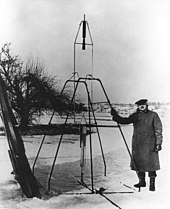
The first commercial method of producing oxygen was chemical, the so-called Brin process involving a reversible reaction of barium oxide. It was invented in 1852 and commercialized in 1884, but was displaced by newer methods in early 20th century.
By the late 19th century scientists realized that air could be liquefied and its components isolated by compressing and cooling it. Using a

In 1891 Scottish chemist James Dewar was able to produce enough liquid oxygen for study.[26] The first commercially viable process for producing liquid oxygen was independently developed in 1895 by German engineer Carl von Linde and British engineer William Hampson. Both men lowered the temperature of air until it liquefied and then distilled the component gases by boiling them off one at a time and capturing them separately.[27] Later, in 1901, oxyacetylene welding was demonstrated for the first time by burning a mixture of acetylene and compressed O
2. This method of welding and cutting metal later became common.[27]
In 1923, the American scientist
In academic laboratories, oxygen can be prepared by heating together potassium chlorate mixed with a small proportion of manganese dioxide.[29]
Oxygen levels in the atmosphere are trending slightly downward globally, possibly because of fossil-fuel burning.[30]
Characteristics
Properties and molecular structure

At
2, referred to as dioxygen.[32]
As dioxygen, two oxygen atoms are
This combination of cancellations and σ and π overlaps results in dioxygen's double-bond character and reactivity, and a triplet electronic

In the triplet form, O
2 molecules are
2 molecules.[26] Liquid oxygen is so magnetic that, in laboratory demonstrations, a bridge of liquid oxygen may be supported against its own weight between the poles of a powerful magnet.[35][c]
Singlet oxygen is a name given to several higher-energy species of molecular O
2 in which all the electron spins are paired. It is much more reactive with common organic molecules than is normal (triplet) molecular oxygen. In nature, singlet oxygen is commonly formed from water during photosynthesis, using the energy of sunlight.[36] It is also produced in the troposphere by the photolysis of ozone by light of short wavelength[37] and by the immune system as a source of active oxygen.[38] Carotenoids in photosynthetic organisms (and possibly animals) play a major role in absorbing energy from singlet oxygen and converting it to the unexcited ground state before it can cause harm to tissues.[39]
Allotropes

The common allotrope of elemental oxygen on Earth is called dioxygen, O
2, the major part of the Earth's atmospheric oxygen (see Occurrence). O2 has a bond length of 121 pm and a bond energy of 498 kJ/mol.[40] O2 is used by complex forms of life, such as animals, in cellular respiration. Other aspects of O
2 are covered in the remainder of this article.
Trioxygen (O
3) is usually known as
The
2 or O
3 and may therefore be used in rocket fuel.[43][44] A metallic phase was discovered in 1990 when solid oxygen is subjected to a pressure of above 96 GPa[46] and it was shown in 1998 that at very low temperatures, this phase becomes superconducting.[47]
Physical properties
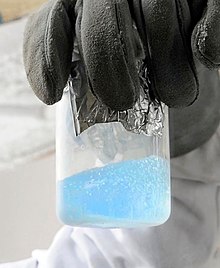
Oxygen
At 5 °C the solubility increases to 9.0 mL (50% more than at 25 °C) per liter for freshwater and 7.2 mL (45% more) per liter for sea water.| 5 °C | 25 °C | |
|---|---|---|
| Freshwater | 9.00 | 6.04 |
| Seawater | 7.20 | 4.95 |
Oxygen condenses at 90.20 K (−182.95 °C, −297.31 °F) and freezes at 54.36 K (−218.79 °C, −361.82 °F).[50] Both liquid and solid O
2 are clear substances with a light sky-blue color caused by absorption in the red (in contrast with the blue color of the sky, which is due to Rayleigh scattering of blue light). High-purity liquid O
2 is usually obtained by the fractional distillation of liquefied air.[51] Liquid oxygen may also be condensed from air using liquid nitrogen as a coolant.[52]
Liquid oxygen is a highly reactive substance and must be segregated from combustible materials.[52]
The spectroscopy of molecular oxygen is associated with the atmospheric processes of aurora and airglow.[53] The absorption in the Herzberg continuum and Schumann–Runge bands in the ultraviolet produces atomic oxygen that is important in the chemistry of the middle atmosphere.[54] Excited-state singlet molecular oxygen is responsible for red chemiluminescence in solution.[55]
Table of thermal and physical properties of oxygen (O2) at atmospheric pressure:[56][57]
| Temperature (K) | Density (kg/m^3) | Specific heat (kJ/kg °C) | Dynamic viscosity (kg/m s) | Kinematic viscosity (m^2/s) | Thermal conductivity (W/m °C) | Thermal diffusivity (m^2/s) | Prandtl Number |
| 100 | 3.945 | 0.962 | 7.64E-06 | 1.94E-06 | 0.00925 | 2.44E-06 | 0.796 |
| 150 | 2.585 | 0.921 | 1.15E-05 | 4.44E-06 | 0.0138 | 5.80E-06 | 0.766 |
| 200 | 1.93 | 0.915 | 1.48E-05 | 7.64E-06 | 0.0183 | 1.04E-05 | 0.737 |
| 250 | 1.542 | 0.915 | 1.79E-05 | 1.16E-05 | 0.0226 | 1.60E-05 | 0.723 |
| 300 | 1.284 | 0.92 | 2.07E-05 | 1.61E-05 | 0.0268 | 2.27E-05 | 0.711 |
| 350 | 1.1 | 0.929 | 2.34E-05 | 2.12E-05 | 0.0296 | 2.90E-05 | 0.733 |
| 400 | 0.962 | 1.0408 | 2.58E-05 | 2.68E-05 | 0.033 | 3.64E-05 | 0.737 |
| 450 | 0.8554 | 0.956 | 2.81E-05 | 3.29E-05 | 0.0363 | 4.44E-05 | 0.741 |
| 500 | 0.7698 | 0.972 | 3.03E-05 | 3.94E-05 | 0.0412 | 5.51E-05 | 0.716 |
| 550 | 0.6998 | 0.988 | 3.24E-05 | 4.63E-05 | 0.0441 | 6.38E-05 | 0.726 |
| 600 | 0.6414 | 1.003 | 3.44E-05 | 5.36E-05 | 0.0473 | 7.35E-05 | 0.729 |
| 700 | 0.5498 | 1.031 | 3.81E-05 | 6.93E-05 | 0.0528 | 9.31E-05 | 0.744 |
| 800 | 0.481 | 1.054 | 4.15E-05 | 8.63E-05 | 0.0589 | 1.16E-04 | 0.743 |
| 900 | 0.4275 | 1.074 | 4.47E-05 | 1.05E-04 | 0.0649 | 1.41E-04 | 0.74 |
| 1000 | 0.3848 | 1.09 | 4.77E-05 | 1.24E-04 | 0.071 | 1.69E-04 | 0.733 |
| 1100 | 0.3498 | 1.103 | 5.06E-05 | 1.45E-04 | 0.0758 | 1.96E-04 | 0.736 |
| 1200 | 0.3206 | 1.0408 | 5.33E-05 | 1.661E-04 | 0.0819 | 2.29E-04 | 0.725 |
| 1300 | 0.296 | 1.125 | 5.88E-05 | 1.99E-04 | 0.0871 | 2.62E-04 | 0.721 |
Isotopes and stellar origin

Naturally occurring oxygen is composed of three stable isotopes, 16O, 17O, and 18O, with 16O being the most abundant (99.762% natural abundance).[58]
Most 16O is
Fifteen
Occurrence
| Z | Element | Mass fraction in parts per million | ||
|---|---|---|---|---|
| 1 | Hydrogen | 739,000 | 71 × mass of oxygen (red bar) | |
| 2 | Helium | 240,000 | 23 × mass of oxygen (red bar) | |
| 8 | Oxygen | 10,400 | ||
| 6 | Carbon | 4,600 | ||
| 10 | Neon | 1,340 | ||
| 26 | Iron | 1,090 | ||
| 7 | Nitrogen | 960 | ||
| 14 | Silicon | 650 | ||
| 12 | Magnesium | 580 | ||
| 16 | Sulfur | 440 | ||
Oxygen is the most abundant chemical element by mass in the Earth's
2 by volume) and Venus
2 surrounding those planets is produced solely by the action of ultraviolet radiation on oxygen-containing molecules such as carbon dioxide.

2.
The unusually high concentration of oxygen gas on Earth is the result of the oxygen cycle. This biogeochemical cycle describes the movement of oxygen within and between its three main reservoirs on Earth: the atmosphere, the biosphere, and the lithosphere. The main driving factor of the oxygen cycle is photosynthesis, which is responsible for modern Earth's atmosphere. Photosynthesis releases oxygen into the atmosphere, while respiration, decay, and combustion remove it from the atmosphere. In the present equilibrium, production and consumption occur at the same rate.[69]
Free oxygen also occurs in solution in the world's water bodies. The increased solubility of O
2 at lower temperatures (see Physical properties) has important implications for ocean life, as polar oceans support a much higher density of life due to their higher oxygen content.[70] Water polluted with plant nutrients such as nitrates or phosphates may stimulate growth of algae by a process called eutrophication and the decay of these organisms and other biomaterials may reduce the O
2 content in eutrophic water bodies. Scientists assess this aspect of water quality by measuring the water's biochemical oxygen demand, or the amount of O
2 needed to restore it to a normal concentration.[71]
Analysis

Planetary geologists have measured the relative quantities of oxygen isotopes in samples from the Earth, the Moon, Mars, and meteorites, but were long unable to obtain reference values for the isotope ratios in the Sun, believed to be the same as those of the primordial solar nebula. Analysis of a silicon wafer exposed to the solar wind in space and returned by the crashed Genesis spacecraft has shown that the Sun has a higher proportion of oxygen-16 than does the Earth. The measurement implies that an unknown process depleted oxygen-16 from the Sun's disk of protoplanetary material prior to the coalescence of dust grains that formed the Earth.[73]
Oxygen presents two spectrophotometric absorption bands peaking at the wavelengths 687 and 760 nm. Some remote sensing scientists have proposed using the measurement of the radiance coming from vegetation canopies in those bands to characterize plant health status from a satellite platform.[74] This approach exploits the fact that in those bands it is possible to discriminate the vegetation's reflectance from its fluorescence, which is much weaker. The measurement is technically difficult owing to the low signal-to-noise ratio and the physical structure of vegetation; but it has been proposed as a possible method of monitoring the carbon cycle from satellites on a global scale.
Biological production and role of O2
Photosynthesis and respiration

2 and fixes CO
2 into sugar in what is called a Calvin cycle.
In nature, free oxygen is produced by the
A simplified overall formula for photosynthesis is[77]
- 6 CO2 + 6 H
2O + photons → C
6H
12O
6 + 6 O
2
or simply
- carbon dioxide + water + sunlight → glucose + dioxygen
Photolytic
2 remaining (after production of the water molecule) is released into the atmosphere.[f]
Oxygen is used in mitochondria in the generation of ATP during oxidative phosphorylation. The reaction for aerobic respiration is essentially the reverse of photosynthesis and is simplified as
- C
6H
12O
6 + 6 O
2 → 6 CO2 + 6 H
2O + 2880 kJ/mol
In vertebrates, O
2 diffuses through membranes in the lungs and into red blood cells. Hemoglobin binds O
2, changing color from bluish red to bright red[41] (CO
2 is released from another part of hemoglobin through the Bohr effect). Other animals use hemocyanin (molluscs and some arthropods) or hemerythrin (spiders and lobsters).[68] A liter of blood can dissolve 200 cm3 of O
2.[68]
Until the discovery of anaerobic metazoa,[79] oxygen was thought to be a requirement for all complex life.[80]
An adult human at rest inhales 1.8 to 2.4 grams of oxygen per minute.[83] This amounts to more than 6 billion tonnes of oxygen inhaled by humanity per year.[g]
Living organisms
| Unit | Alveolar pulmonary gas pressures |
Arterial blood oxygen | Venous blood gas |
|---|---|---|---|
kPa |
14.2 | 11[h]-13[h] | 4.0[h]-5.3[h] |
mmHg |
107 | 75[84]-100[84] | 30[85]-40[85] |
The free oxygen
Build-up in the atmosphere

2 build-up in Earth's atmosphere: 1) no O
2 produced; 2) O
2 produced, but absorbed in oceans & seabed rock; 3) O
2 starts to gas out of the oceans, but is absorbed by land surfaces and formation of ozone layer; 4–5) O
2 sinks filled and the gas accumulates
Free oxygen gas was almost nonexistent in
The presence of large amounts of dissolved and free oxygen in the oceans and atmosphere may have driven most of the extant
2 enables aerobic organisms to produce much more ATP than anaerobic organisms.[90] Cellular respiration of O
2 occurs in all eukaryotes
Since the beginning of the Cambrian period 540 million years ago, atmospheric O
2 levels have fluctuated between 15% and 30% by volume.[91] Towards the end of the Carboniferous period (about 300 million years ago) atmospheric O
2 levels reached a maximum of 35% by volume,[91] which may have contributed to the large size of insects and amphibians at this time.[92]
Variations in atmospheric oxygen concentration have shaped past climates. When oxygen declined, atmospheric density dropped, which in turn increased surface evaporation, causing precipitation increases and warmer temperatures.[93]
At the current rate of photosynthesis it would take about 2,000 years to regenerate the entire O
2 in the present atmosphere.[94]
It is estimated that oxygen on Earth will last for about one billion years.[95][96]
Extraterrestrial free oxygen
In the field of
Industrial production

One hundred million tonnes of O
2 are extracted from air for industrial uses annually by two primary methods.[18] The most common method is fractional distillation of liquefied air, with N
2 distilling as a vapor while O
2 is left as a liquid.[18]
The other primary method of producing O
2 is passing a stream of clean, dry air through one bed of a pair of identical
Oxygen gas can also be produced through
2 gas.[71]
Storage
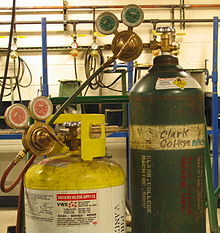
Oxygen storage methods include high-pressure oxygen tanks, cryogenics and chemical compounds. For reasons of economy, oxygen is often transported in bulk as a liquid in specially insulated tankers, since one liter of liquefied oxygen is equivalent to 840 liters of gaseous oxygen at atmospheric pressure and 20 °C (68 °F).[18] Such tankers are used to refill bulk liquid-oxygen storage containers, which stand outside hospitals and other institutions that need large volumes of pure oxygen gas. Liquid oxygen is passed through heat exchangers, which convert the cryogenic liquid into gas before it enters the building. Oxygen is also stored and shipped in smaller cylinders containing the compressed gas; a form that is useful in certain portable medical applications and oxy-fuel welding and cutting.[18]
Applications
Medical

Uptake of O
2 from the air is the essential purpose of
Treatments are flexible enough to be used in hospitals, the patient's home, or increasingly by portable devices. Oxygen tents were once commonly used in oxygen supplementation, but have since been replaced mostly by the use of oxygen masks or nasal cannulas.[103]
2 as soon as possible helps to redissolve the bubbles back into the blood so that these excess gasses can be exhaled naturally through the lungs.[102][110][111] Normobaric oxygen administration at the highest available concentration is frequently used as first aid for any diving injury that may involve inert gas bubble formation in the tissues. There is epidemiological support for its use from a statistical study of cases recorded in a long term database.[112][113][114]
Life support and recreational use

2 is used in space suits.
An application of O
2 as a low-pressure breathing gas is in modern space suits, which surround their occupant's body with the breathing gas. These devices use nearly pure oxygen at about one-third normal pressure, resulting in a normal blood partial pressure of O
2. This trade-off of higher oxygen concentration for lower pressure is needed to maintain suit flexibility.[115][116]
2 with other gases, such as nitrogen or helium, to prevent oxygen toxicity.[117]
People who climb mountains or fly in non-pressurized
Oxygen, as a mild euphoric, has a history of recreational use in oxygen bars and in sports. Oxygen bars are establishments found in the United States since the late 1990s that offer higher than normal O
2 exposure for a minimal fee.[119] Professional athletes, especially in American football, sometimes go off-field between plays to don oxygen masks to boost performance. The pharmacological effect is doubted; a placebo effect is a more likely explanation.[119] Available studies support a performance boost from oxygen enriched mixtures only if it is inhaled during aerobic exercise.[120]
Other recreational uses that do not involve breathing include
Industrial

2 is used to smelt and/or decarburize iron.
Smelting of iron ore into steel consumes 55% of commercially produced oxygen.[71] In this process, O
2 is injected through a high-pressure lance into molten iron, which removes sulfur impurities and excess carbon as the respective oxides, SO
2 and CO
2. The reactions are exothermic, so the temperature increases to 1,700 °C.[71]
Another 25% of commercially produced oxygen is used by the chemical industry.
Most of the remaining 20% of commercially produced oxygen is used in medical applications,
2 to produce a very hot flame. In this process, metal up to 60 cm (24 in) thick is first heated with a small oxy-acetylene flame and then quickly cut by a large stream of O
2.[122]
Compounds

2O) is the most familiar oxygen compound.
The oxidation state of oxygen is −2 in almost all known compounds of oxygen. The oxidation state −1 is found in a few compounds such as peroxides.[123] Compounds containing oxygen in other oxidation states are very uncommon: −1/2 (superoxides), −1/3 (ozonides), 0 (elemental, hypofluorous acid), +1/2 (dioxygenyl), +1 (dioxygen difluoride), and +2 (oxygen difluoride).[124]
Oxides and other inorganic compounds
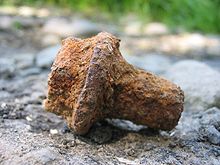
Due to its electronegativity, oxygen forms chemical bonds with almost all other elements to give corresponding oxides. The surface of most metals, such as aluminium and titanium, are oxidized in the presence of air and become coated with a thin film of oxide that passivates the metal and slows further corrosion. Many oxides of the transition metals are non-stoichiometric compounds, with slightly less metal than the chemical formula would show. For example, the mineral FeO (wüstite) is written as , where x is usually around 0.05.[127]
Oxygen is present in the atmosphere in trace quantities in the form of
Water-soluble silicates in the form of Na
4SiO
4, Na
2SiO
3, and Na
2Si
2O
5 are used as detergents and adhesives.[128]
Oxygen also acts as a
2. This class of compounds includes the heme proteins hemoglobin and myoglobin.[129] An exotic and unusual reaction occurs with PtF
6, which oxidizes oxygen to give O2+PtF6−, dioxygenyl hexafluoroplatinate.[130]
Organic compounds
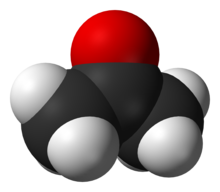
Among the most important classes of organic compounds that contain oxygen are (where "R" is an organic group): alcohols (R-OH); ethers (R-O-R); ketones (R-CO-R); aldehydes (R-CO-H); carboxylic acids (R-COOH); esters (R-COO-R); acid anhydrides (R-CO-O-CO-R); and amides (R-CO-NR
2). There are many important organic solvents that contain oxygen, including: acetone, methanol, ethanol, isopropanol, furan, THF, diethyl ether, dioxane, ethyl acetate, DMF, DMSO, acetic acid, and formic acid. Acetone ((CH
3)
2CO) and phenol (C
6H
5OH) are used as feeder materials in the synthesis of many different substances. Other important organic compounds that contain oxygen are: glycerol, formaldehyde, glutaraldehyde, citric acid, acetic anhydride, and acetamide. Epoxides are ethers in which the oxygen atom is part of a ring of three atoms. The element is similarly found in almost all biomolecules that are important to (or generated by) life.
Oxygen reacts spontaneously with many organic compounds at or below room temperature in a process called autoxidation.[131] Most of the organic compounds that contain oxygen are not made by direct action of O
2. Organic compounds important in industry and commerce that are made by direct oxidation of a precursor include ethylene oxide and peracetic acid.[128]
Safety and precautions
| Hazards | |
|---|---|
| GHS labelling: | |

| |
| H272 | |
| P220, P244, P370+P376, P403 | |
| NFPA 704 (fire diamond) | |
The NFPA 704 standard rates compressed oxygen gas as nonhazardous to health, nonflammable and nonreactive, but an oxidizer. Refrigerated liquid oxygen (LOX) is given a health hazard rating of 3 (for increased risk of hyperoxia from condensed vapors, and for hazards common to cryogenic liquids such as frostbite), and all other ratings are the same as the compressed gas form.[132]
Toxicity

Oxygen gas (O
2) can be
2 by volume (about 30 kPa at standard pressure).[11]
At one time,
2-rich air, but this practice was discontinued after some babies were blinded by the oxygen content being too high.[11]
Breathing pure O
2 in space applications, such as in some modern space suits, or in early spacecraft such as
2 partial pressure in the breathing gas is, in general, about 30 kPa (1.4 times normal), and the resulting O
2 partial pressure in the astronaut's arterial blood is only marginally more than normal sea-level O
2 partial pressure.[136]
Oxygen toxicity to the lungs and
2 partial pressure more than 60 kPa can eventually lead to permanent pulmonary fibrosis.[137] Exposure to an O
2 partial pressure greater than 160 kPa (about 1.6 atm) may lead to convulsions (normally fatal for divers). Acute oxygen toxicity (causing seizures, its most feared effect for divers) can occur by breathing an air mixture with 21% O
2 at 66 m (217 ft) or more of depth; the same thing can occur by breathing 100% O
2 at only 6 m (20 ft).[137][138][139][140]
Combustion and other hazards

2 at higher than normal pressure and a spark led to a fire and the loss of the Apollo 1 crew.
Highly concentrated sources of oxygen promote rapid combustion. Fire and explosion hazards exist when concentrated oxidants and fuels are brought into close proximity; an ignition event, such as heat or a spark, is needed to trigger combustion.[34] Oxygen is the oxidant, not the fuel.
Concentrated O
2 will allow combustion to proceed rapidly and energetically.[34] Steel pipes and storage vessels used to store and transmit both gaseous and liquid oxygen will act as a fuel; and therefore the design and manufacture of O
2 systems requires special training to ensure that ignition sources are minimized.[34] The fire that killed the Apollo 1 crew in a launch pad test spread so rapidly because the capsule was pressurized with pure O
2 but at slightly more than atmospheric pressure, instead of the 1⁄3 normal pressure that would be used in a mission.[l][142]
Liquid oxygen spills, if allowed to soak into organic matter, such as wood, petrochemicals, and asphalt can cause these materials to detonate unpredictably on subsequent mechanical impact.[34]
See also
- Geological history of oxygen
- Hypoxia (environmental) for O
2 depletion in aquatic ecology - Ocean deoxygenation
- Hypoxia (medical), a lack of oxygen
- Limiting oxygen concentration
- Oxygen compounds
- Oxygen plant
- Oxygen sensor
Notes
- ^ These results were mostly ignored until 1860. Part of this rejection was due to the belief that atoms of one element would have no chemical affinity towards atoms of the same element, and part was due to apparent exceptions to Avogadro's law that were not explained until later in terms of dissociating molecules.
- ^ An orbital is a concept from quantum mechanics that models an electron as a wave-like particle that has a spatial distribution about an atom or molecule.
- ^ Oxygen's paramagnetism can be used analytically in paramagnetic oxygen gas analysers that determine the purity of gaseous oxygen. ("Company literature of Oxygen analyzers (triplet)". Servomex. Archived from the original on March 8, 2008. Retrieved December 15, 2007.)
- ^ Figures given are for values up to 80 km (50 mi) above the surface
- ^ Thylakoid membranes are part of chloroplasts in algae and plants while they simply are one of many membrane structures in cyanobacteria. In fact, chloroplasts are thought to have evolved from cyanobacteria that were once symbiotic partners with the progenitors of plants and algae.
- are also required for the reaction to occur. (Raven 2005)
- ^ (1.8 grams/min/person)×(60 min/h)×(24 h/day)×(365 days/year)×(6.6 billion people)/1,000,000 g/t=6.24 billion tonnes
- ^ a b c d Derived from mmHg values using 0.133322 kPa/mmHg
- ^ The reason is that increasing the proportion of oxygen in the breathing gas at low pressure acts to augment the inspired O
2 partial pressure nearer to that found at sea-level. - polar molecule. The interactions between the different dipolesof each molecule cause a net attraction force.
- ^ Since O
2's partial pressure is the fraction of O
2 times the total pressure, elevated partial pressures can occur either from high O
2 fraction in breathing gas or from high breathing gas pressure, or a combination of both. - ^ No single ignition source of the fire was conclusively identified, although some evidence points to an arc from an electrical spark.[141]
References
- ^ "Standard Atomic Weights: Oxygen". CIAAW. 2009.
- ISSN 1365-3075.
- ISBN 0-8493-0464-4.
- ISBN 978-1-4641-8395-9
- ISBN 978-1-4160-4574-8.
- ISBN 978-0-19-856878-0.
- ISBN 978-0-8369-0568-7. Archivedfrom the original on October 1, 2021. Retrieved August 23, 2020.
- ^ a b c d e Cook & Lauer 1968, p. 499.
- ^ a b c Chisholm, Hugh, ed. (1911). . Encyclopædia Britannica. Vol. 17 (11th ed.). Cambridge University Press. pp. 938–39.
- ^ ISBN 978-0-669-32727-4. Archivedfrom the original on April 17, 2020. Retrieved December 16, 2007.
- ^ a b c d e f Emsley 2001, p. 299
- S2CID 170422925.
- ISBN 978-0-309-08905-0.
- ^ a b Marples, Frater James A. "Michael Sendivogius, Rosicrucian, and Father of Studies of Oxygen" (PDF). Societas Rosicruciana in Civitatibus Foederatis, Nebraska College. pp. 3–4. Archived (PDF) from the original on May 8, 2020. Retrieved May 25, 2018.
- ^ from the original on October 1, 2021. Retrieved August 23, 2020.
- ^ "Oxygen". RSC.org. Archived from the original on January 28, 2017. Retrieved December 12, 2016.
- ^ a b c d e f g h i Cook & Lauer 1968, p. 500
- ^ a b c d e f g h Emsley 2001, p. 300
- .
- ^ a b c Parks, G. D.; Mellor, J. W. (1939). Mellor's Modern Inorganic Chemistry (6th ed.). London: Longmans, Green and Co.
- ISBN 978-0-08-037941-8.
- ^ DeTurck, Dennis; Gladney, Larry; Pietrovito, Anthony (1997). "Do We Take Atoms for Granted?". The Interactive Textbook of PFP96. University of Pennsylvania. Archived from the original on January 17, 2008. Retrieved January 28, 2008.
- ^ Roscoe, Henry Enfield; Schorlemmer, Carl (1883). A Treatise on Chemistry. D. Appleton and Co. p. 38.
- ^ ISBN 978-0-7503-0287-6.
- PMC 3826198.
- ^ a b Emsley 2001, p. 303
- ^ a b c "Oxygen". How Products are Made. The Gale Group, Inc. 2002. Archived from the original on April 3, 2019. Retrieved December 16, 2007.
- ^ "Goddard-1926". NASA. Archived from the original on November 8, 2007. Retrieved November 18, 2007.
- ^ Flecker, Oriel Joyce (1924). A school chemistry. MIT Libraries. Oxford, Clarendon press. p. 30.
- ^ Scripps Institute. "Atmospheric Oxygen Research". Archived from the original on July 25, 2017. Retrieved October 8, 2011.
- ^ accessed January 31, 2015.
- ^ "Oxygen Facts". Science Kids. February 6, 2015. Archived from the original on May 7, 2020. Retrieved November 14, 2015.
- ^ Jakubowski, Henry. "Chapter 8: Oxidation-Phosphorylation, the Chemistry of Di-Oxygen". Biochemistry Online. Saint John's University. Archived from the original on October 5, 2018. Retrieved January 28, 2008.
- ^ a b c d e Werley, Barry L., ed. (1991). ASTM Technical Professional training. Fire Hazards in Oxygen Systems. Philadelphia: ASTM International Subcommittee G-4.05.
- ^ "Demonstration of a bridge of liquid oxygen supported against its own weight between the poles of a powerful magnet". University of Wisconsin-Madison Chemistry Department Demonstration lab. Archived from the original on December 17, 2007. Retrieved December 15, 2007.
- PMID 15310815.
- ISBN 978-0-85186-283-5.
- S2CID 36537588.
- S2CID 3965039.
- ^ Chieh, Chung. "Bond Lengths and Energies". University of Waterloo. Archived from the original on December 14, 2007. Retrieved December 16, 2007.
- ^ ISBN 978-0-19-508083-4.
- ^ "Atomic oxygen erosion". Archived from the original on June 13, 2007. Retrieved August 8, 2009.
- ^ PMID 12404493.
- ^ a b Ball, Phillip (September 16, 2001). "New form of oxygen found". Nature News. Archived from the original on October 21, 2013. Retrieved January 9, 2008.
- S2CID 4384225.
- .
- S2CID 205001394.
- ^ "Air solubility in water". The Engineering Toolbox. Archived from the original on April 4, 2019. Retrieved December 21, 2007.
- ISBN 978-0-8493-2022-4.
- ISBN 978-0-8493-0595-5.
- ^ "Overview of Cryogenic Air Separation and Liquefier Systems". Universal Industrial Gases, Inc. Archived from the original on October 21, 2018. Retrieved December 15, 2007.
- ^ a b "Liquid Oxygen Material Safety Data Sheet" (PDF). Matheson Tri Gas. Archived from the original (PDF) on February 27, 2008. Retrieved December 15, 2007.
- S2CID 96242703.
- ISBN 978-1-4020-3824-2. Archivedfrom the original on February 2, 2017. Retrieved July 2, 2015.
- .
- OCLC 46959719.
- )
- ^ a b c d "Oxygen Nuclides / Isotopes". EnvironmentalChemistry.com. Archived from the original on July 12, 2012. Retrieved December 17, 2007.
- ^ a b c Meyer, B. S. (September 19–21, 2005). Nucleosynthesis and Galactic Chemical Evolution of the Isotopes of Oxygen (PDF). Workgroup on Oxygen in the Earliest Solar System. Proceedings of the NASA Cosmochemistry Program and the Lunar and Planetary Institute. Gatlinburg, Tennessee. 9022. Archived (PDF) from the original on December 29, 2010. Retrieved January 22, 2007.
- .
- ^ Starr, Michelle (August 30, 2023). "Scientists Have Observed A Never-Before-Seen Form of Oxygen". ScienceAlert. Retrieved August 30, 2023.
- ^ "NUDAT 13O". Archived from the original on June 9, 2022. Retrieved July 6, 2009.
- ^ "NUDAT 14O". Archived from the original on June 7, 2022. Retrieved July 6, 2009.
- ^ "NUDAT 15O". Archived from the original on June 7, 2022. Retrieved July 6, 2009.
- ISBN 978-0-385-47214-2. Archivedfrom the original on May 13, 2011. Retrieved December 2, 2011.
- ^ Emsley 2001, p. 297
- ^ "Oxygen". Los Alamos National Laboratory. Archived from the original on October 26, 2007. Retrieved December 16, 2007.
- ^ a b c d Emsley 2001, p. 298
- ISBN 978-0-08-037941-8.
- ^ From The Chemistry and Fertility of Sea Waters by H.W. Harvey, 1955, citing C.J.J. Fox, "On the coefficients of absorption of atmospheric gases in sea water", Publ. Circ. Cons. Explor. Mer, no. 41, 1907. Harvey notes that according to later articles in Nature, the values appear to be about 3% too high.
- ^ a b c d e f g h Emsley 2001, p. 301
- ^ a b Emsley 2001, p. 304
- S2CID 789382.
- ISBN 0-7803-7929-2.
- ISBN 978-1-4289-2397-3. Archivedfrom the original on March 25, 2015. Retrieved August 23, 2020.
- ^ Walker, J. C. G. (1980). The oxygen cycle in the natural environment and the biogeochemical cycles. Berlin: Springer-Verlag.
- ISBN 978-0-13-048450-5.
- ^ a b Raven 2005, 115–27
- PMID 20370908.
- ISBN 978-0-387-98701-9.
- ^ "NASA Research Indicates Oxygen on Earth 2.5 Billion Years ago" (Press release). NASA. September 27, 2007. Archived from the original on March 13, 2008. Retrieved March 13, 2008.
- ^ Zimmer, Carl (October 3, 2013). "Earth's Oxygen: A Mystery Easy to Take for Granted". The New York Times. Archived from the original on May 16, 2020. Retrieved October 3, 2013.
- ^ "Flow restrictor for measuring respiratory parameters". Archived from the original on May 8, 2020. Retrieved August 4, 2019.
- ^ a b Normal Reference Range Table Archived December 25, 2011, at the Wayback Machine from The University of Texas Southwestern Medical Center at Dallas. Used in Interactive Case Study Companion to Pathologic basis of disease.
- ^ a b The Medical Education Division of the Brookside Associates--> ABG (Arterial Blood Gas) Archived August 12, 2017, at the Wayback Machine Retrieved on December 6, 2009
- ISBN 978-0-7645-7419-1.
- ^ S2CID 4464710.
- ^ Iron in primeval seas rusted by bacteria Archived March 11, 2020, at the Wayback Machine, ScienceDaily, April 23, 2013
- ISBN 978-0-8053-7171-0.
- ISBN 978-0-13-140941-5.
- ^ PMID 10500106.
- S2CID 31074331.
- from the original on July 13, 2017. Retrieved June 12, 2015.
- PMID 5859927.
- S2CID 232083548– via www.nature.com.
- ^ "How much longer will the oxygen-rich atmosphere be sustained on Earth?". EurekAlert!.
- ^ Paul Scott Anderson (January 3, 2019). "Oxygen and life: a cautionary tale". Archived from the original on January 22, 2021. Retrieved December 29, 2020.
- PMID 25629240.
- S2CID 17414970.
- doi:10.1086/305604.
- ^ "Non-Cryogenic Air Separation Processes". UIG Inc. 2003. Archived from the original on October 3, 2018. Retrieved December 16, 2007.
- ^ a b Cook & Lauer 1968, p. 510
- S2CID 205248111.
- PMID 8931286. Archived from the original on August 11, 2011. Retrieved September 22, 2008.)
{{cite journal}}: CS1 maint: unfit URL (link - ^ Undersea and Hyperbaric Medical Society. "Indications for hyperbaric oxygen therapy". Archived from the original on September 12, 2008. Retrieved September 22, 2008.
- ^ Undersea and Hyperbaric Medical Society. "Carbon Monoxide". Archived from the original on July 25, 2008. Retrieved September 22, 2008.
- PMID 15233173. Archived from the original on February 3, 2011. Retrieved September 22, 2008.)
{{cite journal}}: CS1 maint: unfit URL (link - ^ Hart GB; Strauss MB (1990). "Gas Gangrene – Clostridial Myonecrosis: A Review". J. Hyperbaric Med. 5 (2): 125–44. Archived from the original on February 3, 2011. Retrieved September 22, 2008.
{{cite journal}}: CS1 maint: unfit URL (link) - ^ Zamboni WA; Riseman JA; Kucan JO (1990). "Management of Fournier's Gangrene and the role of Hyperbaric Oxygen". J. Hyperbaric Med. 5 (3): 177–86. Archived from the original on February 3, 2011. Retrieved September 22, 2008.
{{cite journal}}: CS1 maint: unfit URL (link) - ^ Undersea and Hyperbaric Medical Society. "Decompression Sickness or Illness and Arterial Gas Embolism". Archived from the original on July 5, 2008. Retrieved September 22, 2008.
- ^ Acott, C. (1999). "A brief history of diving and decompression illness". South Pacific Underwater Medicine Society Journal. 29 (2). Archived from the original on September 5, 2011. Retrieved September 22, 2008.
{{cite journal}}: CS1 maint: unfit URL (link) - S2CID 3236557. Archived from the original(PDF) on October 1, 2018 – via Rubicon Research Repository.
- ^ "Emergency Oxygen for Scuba Diving Injuries". Divers Alert Network. Archived from the original on April 20, 2020. Retrieved October 1, 2018.
- ^ "Oxygen First Aid for Scuba Diving Injuries". Divers Alert Network Europe. Archived from the original on June 10, 2020. Retrieved October 1, 2018.
- ^ PMID 11541018.
- PMID 2730484.
- ^ a b c d Acott, C. (1999). "Oxygen toxicity: A brief history of oxygen in diving". South Pacific Underwater Medicine Society Journal. 29 (3). Archived from the original on December 25, 2010. Retrieved September 21, 2008.
{{cite journal}}: CS1 maint: unfit URL (link) - PMID 17393938. Archived from the original on June 13, 2008. Retrieved September 21, 2008.)
{{cite journal}}: CS1 maint: unfit URL (link - ^ PMID 12523293. Archived from the originalon October 18, 2007. Retrieved December 23, 2007.
- ^ "Ergogenic Aids". Peak Performance Online. Archived from the original on September 28, 2007. Retrieved January 4, 2008.
- ^ "George Goble's extended home page (mirror)". Archived from the original on February 11, 2009. Retrieved March 14, 2008.
- ^ Cook & Lauer 1968, p. 508
- ISBN 978-0-08-037941-8., p. 28
- ^ IUPAC: Red Book. Archived July 9, 2018, at the Wayback Machine pp. 73, 320.
- PMID 17115729.
- ^ Chaplin, Martin (January 4, 2008). "Water Hydrogen Bonding". Archived from the original on October 10, 2007. Retrieved January 6, 2008.
- ISBN 978-0-7487-7516-3.
- ^ a b Cook & Lauer 1968, p. 507
- ISBN 978-0-471-18423-2.
- ^ Cook & Lauer 1968, p.505
- ^ Cook & Lauer 1968, p. 506
- ^ "NFPA 704 ratings and id numbers for common hazardous materials" (PDF). Riverside County Department of Environmental Health. Archived (PDF) from the original on July 11, 2019. Retrieved August 22, 2017.
- ^ Dharmeshkumar N Patel; Ashish Goel; SB Agarwal; Praveenkumar Garg; et al. (2003). "Oxygen Toxicity" (PDF). Indian Academy of Clinical Medicine. 4 (3): 234. Archived from the original (PDF) on September 22, 2015. Retrieved April 26, 2009.
- ^ Cook & Lauer 1968, p. 511
- ^ Wade, Mark (2007). "Space Suits". Encyclopedia Astronautica. Archived from the original on December 13, 2007. Retrieved December 16, 2007.
- ^ Martin, Lawrence. "The Four Most Important Equations In Clinical Practice". GlobalRPh. David McAuley. Archived from the original on September 5, 2018. Retrieved June 19, 2013.
- ^ PMID 9765173.
- ISBN 978-1-85421-176-7.
- PMID 20248086.
- PMID 20248096.
- ^ Report of Apollo 204 Review Board NASA Historical Reference Collection, NASA History Office, NASA HQ, Washington, DC
- ISBN 978-0-06-662082-4.
General references
- Cook, Gerhard A.; Lauer, Carol M. (1968). "Oxygen". In Clifford A. Hampel (ed.). The Encyclopedia of the Chemical Elements. New York: Reinhold Book Corporation. pp. 499–512. LCCN 68-29938.
- Emsley, John (2001). "Oxygen". Nature's Building Blocks: An A–Z Guide to the Elements. Oxford, England: Oxford University Press. pp. 297–304. ISBN 978-0-19-850340-8.
- Raven, Peter H.; Evert, Ray F.; Eichhorn, Susan E. (2005). Biology of Plants (7th ed.). New York: W. H. Freeman and Company Publishers. pp. 115–27. ISBN 978-0-7167-1007-3.
External links
- Oxygen at The Periodic Table of Videos(University of Nottingham)
- Oxidizing Agents > Oxygen
- Oxygen (O2) Properties, Uses, Applications
- Roald Hoffmann article on "The Story of O"
- WebElements.com – Oxygen
- Oxygen on In Our Time at the BBC
- Scripps Institute: Atmospheric Oxygen has been dropping for 20 years


